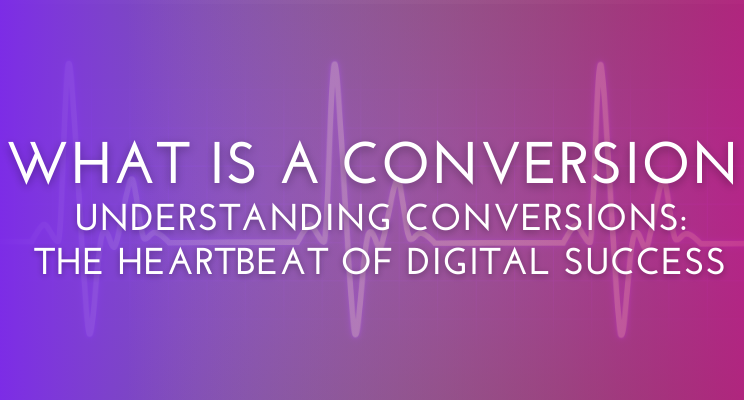In the ever-evolving digital landscape, the concept of a ‘conversion’ often becomes the focal point of discussions, strategies, and goals, especially for businesses striving to thrive online. And to put it bluntly, defining ‘conversion’ is not a simple task. Why? Because it means different things to different businesses with different goals. So what is a conversion and why does it matter to your business and overarching goals within the digital landscape?
As a social media strategist and the proud owner of a social media agency, I’ve seen firsthand how understanding and optimizing conversions can transform the trajectory of a business. In this blog post, we’ll dive into the essence of what a conversion is, its pivotal role in digital marketing, and how it can shape your business’s online success.
At its core, a conversion is a completed activity that aligns with the objectives of a business or campaign. It’s the moment when a potential customer or lead takes a specific action that you’ve defined as valuable. This action could range from buying your book, swapping their coveted email address for your weekly newsletter or value-packed whitepaper. A conversion is a measurable action that moves the user further along in their buyers journey.
The Many Faces of Digital Conversions
Conversions are not a one-size-fits-all concept. Read that again. The reason this blog even exists is because I’m always defining to my team and to clients alike what the end goal of their social media efforts are in the form of a ‘conversion,’ which as we’ve already defined is not solely a money swap.
They vary significantly based on the nature of your business, the platform you’re using, and the specific goals you’ve set. For an e-commerce site, a conversion might typically be a completed sale. However, for a B2B service provider, book author, speaker,or thought leader it could be a scheduled consultation or a downloaded resource. The conversion is defined as a new lead acquired – sharing their contact information, growing your email list in exchange for something of value. Understanding the specific conversion actions that align with your business objectives is crucial for measuring success and optimizing strategies.
Measuring and Optimizing Conversions
Understanding your conversion rates is key to gauging the effectiveness of your strategies. The conversion rate is calculated by taking the number of completed conversions and dividing it by the total number of visitors. This metric offers invaluable insights into how well your site or campaign converts traffic into desired outcomes.
How do you measure this? Google Analytics is a treasure trove of data (that for the novice, can and does get a bit cumbersome), however from the social media perspective it allows us to dial in what social media platform is generating the most traffic and is that traffic garnering any results, like new sign ups, downloads, digital product purchases.
Note: You have to define those desired outcomes first and yes, they have to be attainable based on the data you already have to pull from.
But it’s not just about measuring; it’s also about optimizing. Continuous analysis and optimization are necessary to improve these rates. This might involve A/B testing different call-to-action phrases, tweaking landing page designs (hint: make opt-in forms 2 fields or less when possible), or refining your ad targeting. The digital landscape is dynamic, and so should be your approach to managing conversions.
The Psychological Aspect of Conversions
Behind every click or form submission is a human decision.
And humans take more time these days to make decisions because there are a plethora of options out there. It’s up to you to build that trust overtime and hold their hand as you walk them through their customer journey. As you’re shaping your lead magnet landing pages and crafting your copy of graphics for social media, always be thinking about your audience and what makes them take action. Consider adding elements like social proof, authority, reciprocity, and scarcity can significantly impact conversion rates. Crafting messages and experiences that resonate with these psychological triggers can make a substantial difference in your conversion success.
Conversions in the Social Media Realm
In the context of social media, conversions take on a unique dynamic. Social platforms offer a variety of opportunities for businesses to engage with their audience internally on the platforms as well as externally by driving traffic off the platforms onto a website/landing page you own. But something that will not change in the social media landscape is the fact that social media is a marketing tool for those of us in the B2B space. So if you’re looking to close a $3k a month client from social media right off the bat, I suggest you refocus your goals. To track desired actions from social media, its essential to Connect The Digital Dots™ through Google Analytics, see the section above regarding measuring the results.
My Final Thoughts
If you do not define what a conversion is within your business, you will not fully understand if the level of effort your deploying on social media or other marketing efforts are generating the desired results and outcomes. This is priority numero uno!
Tough love…you ready? Until you know what actions are valuable to your business, guiding your audience towards these actions, and continuously refining your approach based on performance data is forever going to be a challenge. In the digital arena, where every click holds potential, mastering the art of conversions is not just beneficial; it’s essential.
If you want a helping hand from an experienced team like the Squad here at Oh Snap! Social reach out for your Pulse Check Audit and Strategy — this is the first step to understanding what’s working and what’s not and getting to the bottom of what realistic goals should be propped up for your business. Get in touch with us here.

